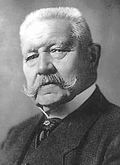Born in the family of a Prussian military officer and landowner, Hindenburg also chose a military career and graduated from cadet school in 1866. He participated in the wars with Austria and France and rose in rank until he became general in 1911 and retired. Three weeks after the beginning of World War I, Hindenburg was called back into service and took over as commander in chief of the 8th German army involved in military actions against the Russian troops. He was promoted to colonel-general (27 Aug 1914). On 1 Nov 1914, Hindenburg was appointed commander in chief of the German armies in the eastern front and promoted to field marshal (27 Nov 1914). After major victories over Russians, Emperor Wilhelm II agreed to appoint Hindenburg as commander of all German armies in 1916. After the November revolution in 1918, Hindenburg and the army swore an oath of allegiance to the government of Friedrich Ebert, but he retired again in June 1919. Hindenburg did not play any role in German politics until 1925, when he was convinced by nationalist politicians to run for president at the elections held after the death of Ebert. Although a supporter of monarchy, Hindenburg made no attempts to return to the old regime, but he imposed authoritarian style of governing. When his governments faced the Great Depression, which deeply struck Germany, he provided the Reich government with additional powers including a right to dissolve the Reichstag. The political crisis followed in 1930 and resulted in the Reichstag's dissolution. The new parliament proved to be even less cooperative than its predecessor and Hindenburg introduced the system of presidential cabinets (Präsidialkabinett) governing without party support in Reichstag, where National Socialists became the second largest party. In early 1932, the political crisis and the advanced age of Hindenburg, who was 83, provided the Reich chancellor Heinrich Brüning with an excuse to propose the extension of presidential term without elections, but the Reichstag declined the proposal. At the elections in March/April 1932, Hindenburg won over the National Socialist candidate Adolf Hitler with the support of the Catholic Centre Party and the Social Democrats. However, the short-lived governments of Franz von Papen (1 Jun 1932 - 3 Dec 1932) and Kurt von Schleicher (3 Dec 1932 - 30 Jan 1933) were unable to prevent the advancement of the Nazis, who received 230 seats in the Reichstag elected in July 1932 and became a major political force in Germany. In the fall of 1932, the Nazis lost more than 30 seats, but Papen and Hitler agreed on forming a government. After futile attempts to receive parliamentary approval for the new cabinet, Hindenburg dismissed Schleicher and appointed Hitler Reich Chancellor (30 Jan 1933). Through terror and manipulations Hitler and his party assumed full control over the country and forced dissolution of political parties. Hindenburg supported the destruction of the Weimar republic remaining a figurehead in the early Nazi Germany. On 1 Aug 1934 the Hitler's government decreed that the offices of Reich President and Reich Chancellor would be merged upon Hindenburg's death, which followed the next day. Sources: Maser, Werner. Hindenburg. Eine politische Biographie. Rastatt: Moewig, 1989. |
| Candidate (party) |
Popular vote (1st round: 29 Mar 1925) |
| registered voters |
38,846,897 |
| returned ballots |
368,335 |
| invalid votes |
150,640 |
| valid votes |
26,866,103 |
| Otto Braun (Social Democratic) |
7,802,496 |
| Heinrich Held (Bavarian People's Party) |
1,007,450 |
| Willy Hellpach (Democratic) |
1,568,398 |
| Karl Jarres (People's Party) |
10,416,655 |
| Erich Ludwig Ludendorff (populist) |
285,793 |
| Wilhelm Marx (Centre Party [Catholic]) |
3,887,734 |
| Ernst Thälmann (Communist) |
1,871,815 |
| scattered |
25,762 |
| |
|
| Candidate (party) |
Popular vote (2nd round: 26 Apr 1925) |
| registered voters |
38,928,957 |
| returned ballots |
493,704 |
| invalid votes |
216,051 |
| valid votes |
30,351,948 |
| Paul von Hindenburg (Reichsblock) |
14,655,766 (48.3%) |
| Wilhelm Marx (Centre Party [Catholic]) |
13,751,615 (45.3%) |
| Ernst Thälmann (Communist) |
1,931,151 (6.4%) |
| scattered |
13,416 (0.04%) |
| |
|
| Candidate (party) |
Popular vote (1st round: 13 Mar 1932) |
| registered voters |
43,949,681 |
| valid votes |
37,648,317 |
| Theodor Duesterberg (Stahlhelm) |
2,557,729 (6.8%) |
| Paul von Hindenburg |
18,651,497 (49.6%) |
| Adolf Hitler (National Socialist - NSDAP) |
11,339,446 (30.1%) |
| Ernst Thälmann (Communist) |
4,983,341 (13.2%) |
| Gustav Winter (Inflation-damaged) |
111,423 (0.3%) |
| scattered |
4,881 (0.0%) |
| |
|
| Candidate (party) |
Popular vote (2nd round: 10 Apr 1932) |
| registered voters |
43,386,757 |
| returned ballots |
659,809 |
| invalid votes |
280,926 |
| valid votes |
36,489,811 |
| Paul von Hindenburg |
19,359,633 (53.0%) |
| Adolf Hitler (National Socialist - NSDAP) |
13,418,051 (36.8%) |
| Ernst Thälmann (Communist) |
3,706,655 (10.2%) |
| scattered |
5,472 (0.0%) |
|
| Information source (officially approved results): Deutscher Reichsanzeiger und Preußischer Staatsanzeiger, No. 84, 9 Apr 1925, p. 1; Deutscher Reichsanzeiger und Preußischer Staatsanzeiger, No. 105, 6 May 1925, p. 1; Deutscher Reichsanzeiger und Preußischer Staatsanzeiger, No. 96, 25 Apr 1932, p. 1; (statistics): Statistisches Jahrbuch für das Deutsche Reich : Herausgegeben vom Statistischen Reichsamt : Einundfünfzigster Jahrgang 1932. Berlin: Reimar Hobbing, 1932, pp. 546-547. |

